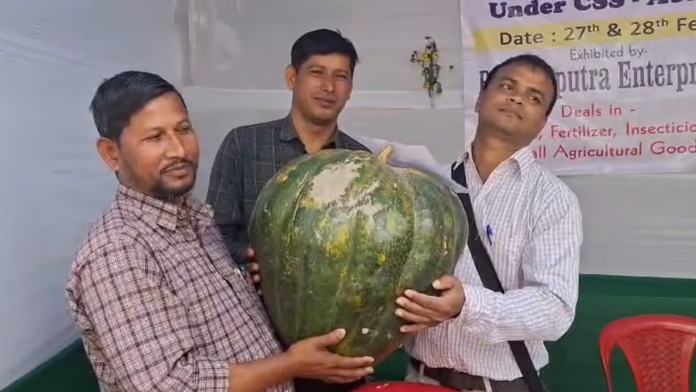In an exciting showcase of agricultural excellence, a gigantic 38-kilogram pumpkin has become the highlight of the Kisan Mela in Dhubri, Assam. The event, organized by the Agricultural Technology Management Agency (ATMA) in collaboration with the Dhubri District Agriculture Department, has provided a platform for local farmers to display their produce and innovations in farming. However, it was the massive pumpkin, cultivated in the char region of Dimatola, that stole the show, attracting admiration from visitors, agricultural experts, and fellow farmers alike.
The pumpkin was grown on a 10-bigha farm belonging to Abu Lahel Bakey, a hardworking farmer from Dimatola, an area known for its fertile river-island lands. His farm is part of a larger 200-bigha agricultural estate, where he cultivates a variety of crops, including chilies, eggplants, potatoes, pumpkins, and oilseeds like sesame, black gram, and mustard.
Despite the rich agricultural potential of char lands, farmers like Bakey face several challenges related to transportation, infrastructure, and market access, which threaten their ability to earn a sustainable income.
The Agricultural Potential of Assam’s Char Lands
Assam’s char lands—the temporary river-island formations created by sediment deposits—are highly fertile and have the capacity to produce high-quality crops. Farmers in these areas primarily grow vegetables, oilseeds, pulses, and seasonal crops, contributing significantly to the state’s agrarian economy.
However, these lands remain disconnected from the mainland, making it difficult for farmers to transport their produce to markets, wholesalers, and consumers. The Kisan Mela in Dhubri provided an opportunity for these farmers to showcase their achievements while also bringing attention to the hardships they endure.
Challenges Faced by Char Farmers in Assam
1. High Transportation Costs
One of the biggest hurdles faced by char farmers is the cost of transporting their produce. Since char lands are often isolated, farmers need to first ferry their crops by boat, followed by road transport to reach markets and wholesalers. The double transportation expense significantly reduces their profits.
“Reaching the mainland is an expensive ordeal. We have to ferry our produce by boat first and then transport it by vehicle. Often, the cost of transportation exceeds the value of the vegetables, leaving us at a loss,” lamented Bakey.
Due to these high logistical costs, many farmers are forced to sell their produce at lower prices or, in some cases, discard unsold crops, leading to financial distress.
2. Lack of Cold Storage Facilities
Another major concern for char farmers is the absence of cold storage units. Without proper storage, perishable crops like vegetables and fruits spoil quickly, forcing farmers to sell at throwaway prices or suffer post-harvest losses.
If cold storage units were established near char regions, farmers could store their produce for longer periods and sell them at competitive rates, improving their income levels.
3. Poor Road Connectivity and Government Neglect
Despite the agricultural significance of char lands, government investment in transport, storage, and irrigation remains inadequate. Most char areas lack proper roads and bridges, making it difficult for farmers to access markets, fertilizers, and farming equipment.
Agricultural experts believe that better road networks, subsidized transportation, and financial aid for char farmers would majorly boost production and profits.
Optimism Amidst Challenges: A Promising Future for Assam’s Agriculture
While char farmers continue to battle challenges, some regions in Dhubri have witnessed a profitable vegetable yield this season, raising hopes for better agricultural prospects. The success of the 38 kg pumpkin has reignited discussions on how better support and infrastructure could transform Assam’s char agriculture into a thriving industry.
The Birsing-Jarua Development Block in Dhubri has been a bright spot in this regard. Farmers in this region have reported high yields and good market sales, proving that with the right infrastructural support, char lands can contribute significantly to Assam’s agricultural economy.
Experts believe that investment in:
- Cold storage units to prevent post-harvest losses
- Improved road and ferry transport to reduce logistics costs
- Market linkages for direct sales to buyers
- Government subsidies for char farmers
would lead to a major agricultural transformation in Assam.
The 38 kg pumpkin from Dimatola may have captured the spotlight at Dhubri’s Kisan Mela, but it also serves as a symbol of both the immense potential and the struggles of Assam’s char farmers.
While these fertile river-island lands can produce record-breaking crops, the lack of transportation, storage, and infrastructure continues to hinder economic progress for farmers. Without proper roads, ferry services, and market support, farmers will remain trapped in a cycle of low earnings and wastage.
The success stories from Dhubri’s Birsing-Jarua region prove that with the right investment and policy changes, Assam’s char agriculture can flourish, benefiting both farmers and the state’s economy.




